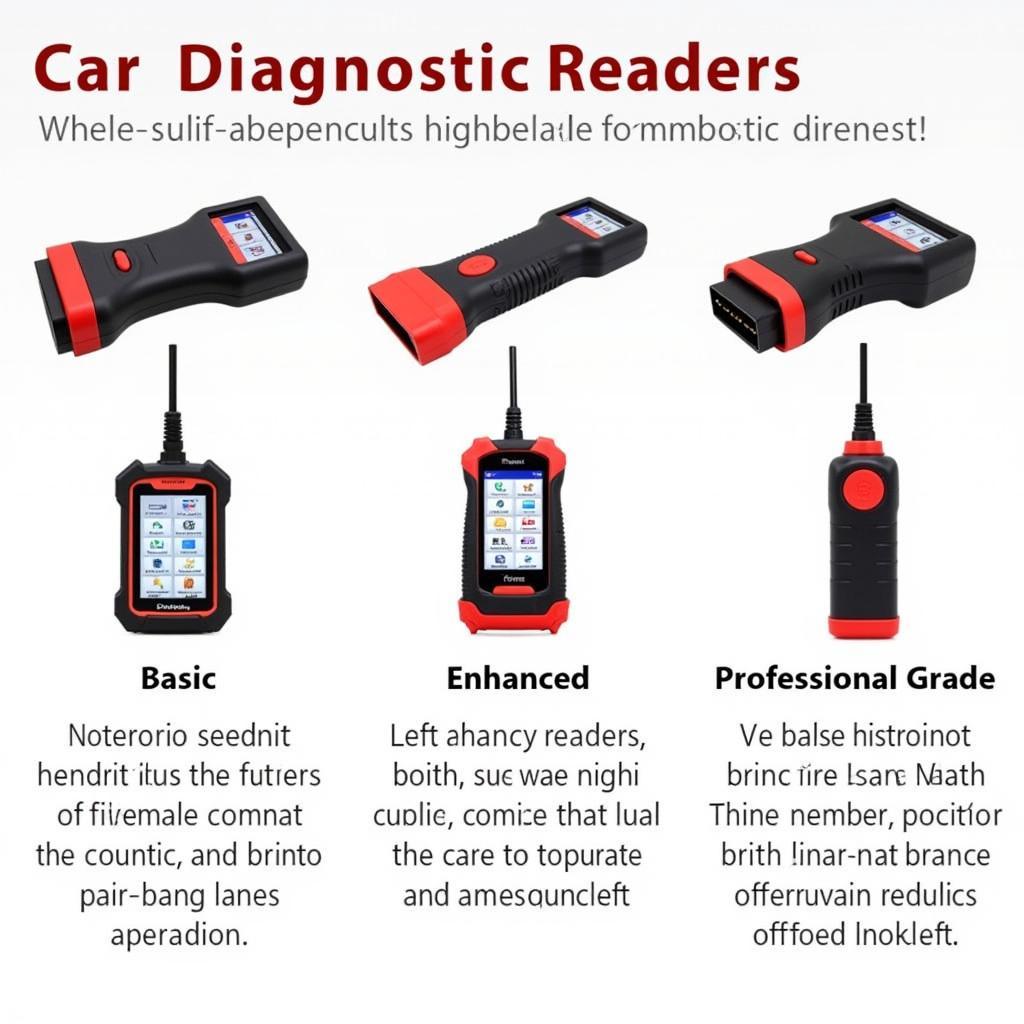A Car Diagnostic Reader is an invaluable tool for anyone who owns a car, from seasoned mechanics to everyday drivers. Understanding how these devices work, what they can do, and how to choose the right one can save you time, money, and frustration in the long run. This guide will cover everything you need to know about car diagnostic readers.
What is a Car Diagnostic Reader and Why Do You Need One?
A car diagnostic reader, also known as an OBD-II scanner, is an electronic device that connects to your vehicle’s onboard diagnostic system (OBD-II port) to retrieve diagnostic trouble codes (DTCs). These codes provide insights into the potential issues affecting your car’s performance. A car diagnostic reader can help you:
- Identify problems early: Catching potential issues early can prevent minor problems from escalating into major, expensive repairs.
- Save money on diagnostics: Instead of paying a mechanic for diagnostics, you can use a car diagnostic reader to identify the problem yourself.
- Gain a better understanding of your car: Regularly using a car diagnostic reader allows you to monitor your vehicle’s health and understand how different systems interact.
- Negotiate better repair prices: Armed with information from your car diagnostic reader, you’ll be better equipped to discuss repair options and costs with a mechanic.
- Improve fuel efficiency: Identifying and addressing issues that impact fuel economy can save you money at the pump.
You can find a good selection of readers on car diagnostic reader amazon.
Types of Car Diagnostic Readers
There are various types of car diagnostic readers available, each with different features and capabilities. Here’s a breakdown:
- Basic Code Readers: These entry-level readers can retrieve and clear basic DTCs. They are a great option for DIY enthusiasts on a budget.
- Enhanced Code Readers: These readers offer more advanced features than basic code readers, such as live data streaming, freeze frame data, and the ability to view pending codes.
- Professional Scan Tools: These are the most comprehensive and expensive type of car diagnostic reader. They offer advanced diagnostics, bi-directional control, and access to manufacturer-specific codes.
If you’re in the UK, you might want to check out resources specific to your region, such as car diagnostic reader uk.
How to Use a Car Diagnostic Reader
Using a car diagnostic reader is generally straightforward. Follow these simple steps:
- Locate the OBD-II port: The OBD-II port is typically located under the dashboard on the driver’s side.
- Plug in the reader: Connect the car diagnostic reader to the OBD-II port.
- Turn on the ignition: Turn the ignition key to the “on” position without starting the engine.
- Read the codes: The reader will display any stored DTCs. Note down these codes.
- Interpret the codes: Look up the meaning of the codes online or in a repair manual. Resources like the auto tecnik d5793 car diagnostic reader manual can be helpful for specific models.
- Clear the codes: After addressing the issue, use the reader to clear the codes.
 Mechanic using a car diagnostic reader to diagnose a vehicle.
Mechanic using a car diagnostic reader to diagnose a vehicle.
Choosing the Right Car Diagnostic Reader
Choosing the right car diagnostic reader depends on your needs and budget. Consider the following factors:
- Features: Determine what features are important to you, such as live data streaming, ABS diagnostics, and compatibility with your vehicle make and model.
- Budget: Car diagnostic readers range in price from affordable basic code readers to expensive professional scan tools.
- User-friendliness: Choose a reader with an intuitive interface and easy-to-understand instructions.
“Investing in a reliable car diagnostic reader is like having a personal mechanic in your pocket,” says John Davis, a certified automotive technician with over 20 years of experience. “It empowers you to take control of your vehicle’s maintenance and avoid unnecessary trips to the repair shop.”
Conclusion
A car diagnostic reader is an essential tool for any car owner. Whether you’re a DIY enthusiast or just want to be more informed about your car’s health, a car diagnostic reader can provide valuable insights. By understanding how to choose and use a car diagnostic reader, you can save time and money on car repairs while gaining a deeper understanding of your vehicle. Check out options like the car diagnostic reader victor tools for a reputable brand. Understanding the firmware, like the auto tecnik d5793 car diagnostic reader firmware, can be beneficial as well.
FAQ
- What is the OBD-II port? The OBD-II port is a standardized connector that allows access to a vehicle’s onboard diagnostic system.
- Are all car diagnostic readers compatible with all cars? Most modern cars (1996 and newer in the US) are OBD-II compliant.
- Can I fix my car with a car diagnostic reader? A car diagnostic reader helps you identify the problem but doesn’t fix it. Repairs may still be necessary.
- How often should I use a car diagnostic reader? It’s a good practice to scan your car for codes periodically, especially if you notice any unusual performance issues.
- What do I do if my car diagnostic reader doesn’t work? Double-check the connection to the OBD-II port and make sure the ignition is on.
“Regularly checking your car’s diagnostic codes with a reader can preemptively identify potential issues and prevent costly repairs down the road,” advises Sarah Miller, a leading automotive engineer. “It’s a proactive approach to car maintenance that every car owner should embrace.”
 Various car diagnostic readers, from basic to professional.
Various car diagnostic readers, from basic to professional.
Need more assistance? Contact us via WhatsApp: +1(641)206-8880 or Email: [email protected]. Our customer service team is available 24/7.

Leave a Reply